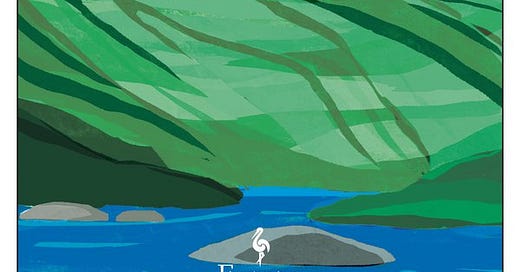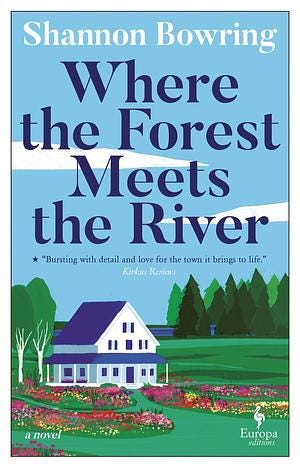What’s in a Name? Only Everything; Or, One Author’s Methodical, Magical Method for Naming Fictional Characters
Shannon Bowring explains her process for naming the characters and places in her two novels set in northern Maine.
Google believes I am perpetually pregnant. Though I have no children (and have happily chosen not to have any in the future), I am inundated with ads for newborn-sized diapers, nursing bras, and maternity clothes. While I admittedly would rather wear stretchy pants than jeans any day, none of the other items offered by these baby-centric retailers apply to me.
So why the prenatal confusion?
The answer is simple, really. You see, I am not a mother. But I am a writer.
Like any other modern author, I rely on internet searches to help me write about everything from the history of Maine logging to 1990s club music. Details are important in fiction, necessary to build a world which readers find both familiar and brand new.
For me, some of the most essential details are the names of the characters who inhabit my stories. And while I find the naming process incredibly fun, I do not take it lightly.
I believe that in fiction, a name should:
Be appropriate for the era and place in which the story is set (unless the character is behind or ahead of their time, in which case the name should reflect this).
Be easy enough to read/pronounce and different enough from other characters’ names in the story so as not to cause confusion for the reader.
Not be the name of a real person you, the author, actually know.
Be pleasing to the eye and the ear (unless the character is a jerk, in which case the name can be as unpleasant as the person who bears it).
Be an indication of the character’s personality, history, culture, class, talents, profession, personal secrets, and hidden potential.
Bearing the above in mind, I follow a specific internet-research routine when deciding my characters’ names.
First, I determine the approximate age of the character, then I work backward to figure out the decade in which they would have been born. Once that pesky math is done, I search for popular baby names in that decade. My favorite website to start from is the Social Security Administration, which might not be sexy but serves as a reliable record of naming-trends in the U.S. from the late 1800s to present day. I don’t necessarily adhere to this list, but it’s a good jumping-off point to imagine other possibilities for that era.
Next, I search the origins and meaning of any first or middle name that appeals to me. This usually leads me to sites like The Bump and Nameberry, platforms dedicated to all things pregnancy- and infant-related: ovulation calculators, charts comparing in-utero babies to the sizes of different fruits, and potential names for your future child. Hence the algorithmic assumption that I, a child-free cat lady, am an expectant parent.
By this point in my research, I usually have a general idea of who the character is, so I can discard any names whose meanings don’t align with the person they seem to be. I choose several names that have potential and write them down, comparing each to other names in the cast of the story to make sure they aren’t too similar. A name should feel recognizable, but not so common as to be forgettable. It also shouldn’t be so original as to be farcical.
For last names, my research is heavily place-based. I refer to genealogical records to get an idea of the people who have populated an area for generations. This is also an opportunity to better understand the culture and identity of the setting my characters inhabit. For example, because so much of my work is based in Northern Maine, I look for common last names of the Acadian, Quebecois, Franco-American, Swedish, Irish, Scottish, and Indigenous people who call this region home. I research the meanings and origins of these surnames as well.
Once I’ve investigated all the potential names for one character, I study my list, speaking each name out loud to see how it sounds—the first, middle, and last name must flow nicely together. I’m able to eliminate a few more this way, until I’m left with one solid last name and two or three options for first and last.
With the finalists in place, I do a few more searches to make sure the name isn’t the same as or too like that of an infamous war criminal or beloved actress. I also run a mental inventory of whether I know anyone with the same name—this is where I ran into trouble with the characters in The Road to Dalton, as there are only so many French-Canadian names an author can make up before one accidentally turns out to belong to a real person.
Once I’m satisfied enough that I have avoided a lawsuit, I make the final decision, which feels as if it should be accompanied with celebratory party hats and cake but is actually just me entering the name into my spreadsheet of character facts and figures. Writing is many things, but it is rarely glamorous.
Though so much of what I have revealed here might sound like a rigid formula, the process of naming a character contains within it something so ephemeral that it feels fated. There are instances where I know a character’s name before I do any research, moments when these fictional but very real people rise from the mysterious depths to whisper their name in my ear.
I have always known, for example, the names of several characters in my Dalton Novels: Nate Theroux, his wife Bridget, and their daughter Sophie. These names rang clear in my mind long before I sat down to write this family’s story, long before I became intimately acquainted with their individual fears, hopes, and inclinations. Knowing, now, the meaning of these characters’ names and who they become over the course of the trilogy, it seems I was right to trust them that first time they introduced themselves to me. Stripping away any religious connotations, the name Nathaniel means gift, a fitting moniker for a kindhearted cop so treasured by his community. Bridget is the exalted one, an apt if not heartbreaking reflection of who she becomes in the lives and memories of those who love her. And Sophie, a young girl filled with curiosity and surprising insight, lives up to the wise and clever origins of her name.
On the flip side, there are moments when a character rejects the name I have chosen for them. Before Gregory Fortin was fully formed in The Road to Dalton, I believed his name was Evan. The more I wrote about him, however, the more he insisted I had it wrong. “I’m supposed to be Greg,” he told me, and I listened. And while the meaning of Evan is pleasant enough—a generic “God is gracious”—the meaning of Gregory—“vigilant, alert”—feels more suited to a person who has spent his life watching the people around him, calibrating his existence to accommodate the insular, often close-minded world into which he was born. In Where the Forest Meets the River, Lila Curtis became Vera after I got to know her and to understand that her narrative was less about “beauty and divine play” and more about her having the faith to trust her instincts in determining what makes a place a true home.
All that to say: Sometimes my exhaustive-yet-exhilarating research leads to my choosing the right name. Other times, the character names themselves, and the meaning surrounding that name’s origins almost magically aligns with who they become on the page, in the telling.
So after everything—all the research, all the ads congratulating me on my nonexistent bundle of joy—the final choice for a character’s name often comes down to something between intuition and divination, a sense of knowing when a name just feels right. Maybe this is akin to a mother knowing, the first time she holds her child, what that child’s name is—not a name she has bookmarked in her own internet searches, but the name this beautiful creature has carried with them from one unknowable world to this one.
Despite what Google might believe, I am not a mother. But as a writer, I have the pleasure and blessing of creating new life, again and again and again.
Shannon Bowring’s award-winning work has appeared in numerous journals, including Best Small Fictions, and has been nominated for Pushcart and Best of the Net prizes. She is the recipient of the 2022 Julia Peterkin Literary Award for Flash Fiction and was selected by Deesha Philyaw as a finalist for the Fractured Lit Anthology II Contest. Her debut novel, The Road to Dalton, was selected as an NPR Best Book in 2023 and won the Maine Literary Book Award for Fiction in 2024. The second book in the Dalton Novels series, Where the Forest Meets the River, was published in September 2024. The third book in the series, In a Distant Valley, is forthcoming from Europa Editions.





